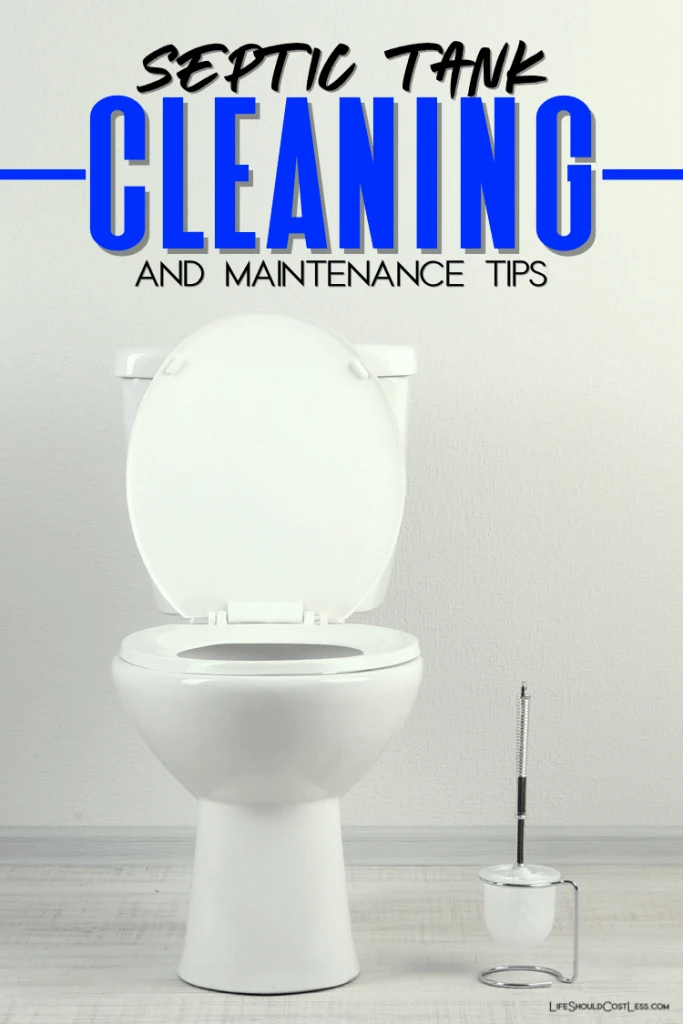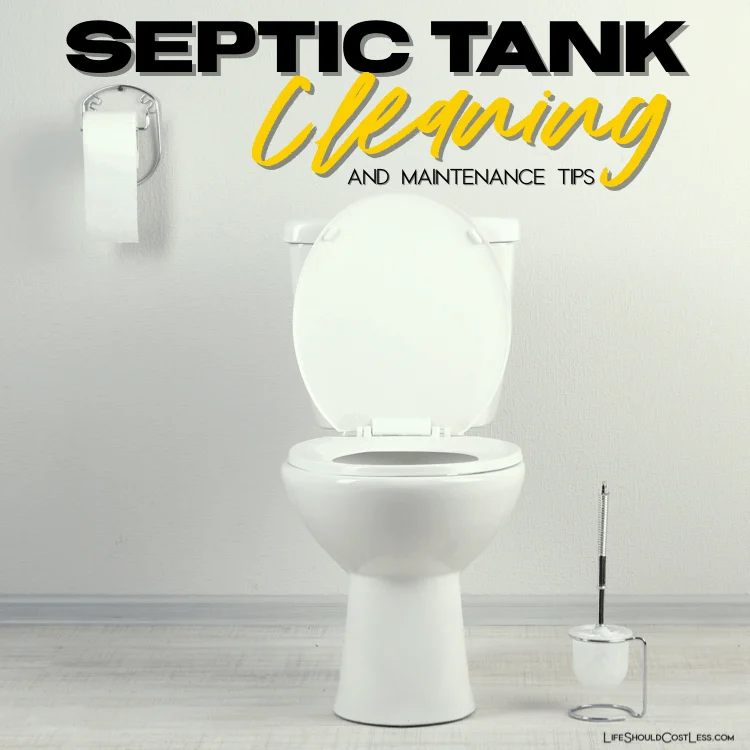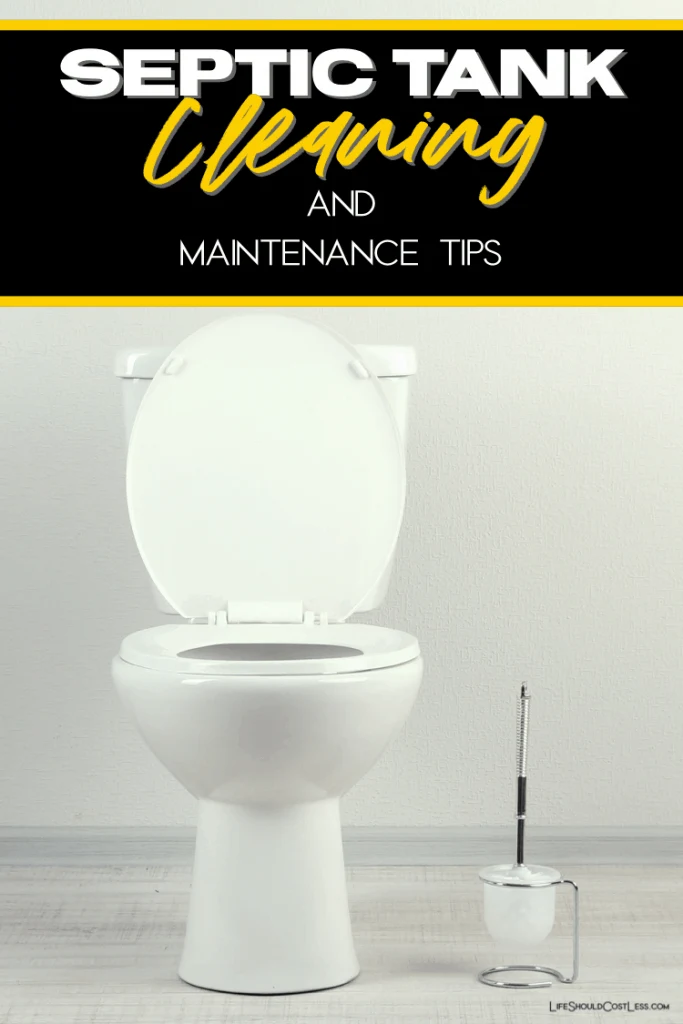Did you know that the best way to save yourself some money when you have a septic tank, is to clean and maintain it regularly? Plus, it can prevent a sewage nightmare by learning how to properly clean and maintain your septic system. The best part is that septic tank care is easier than you may think.

I have wanted to live off-grid for my entire adult life, but it seems that the closest I have ever been able to get it is just a little bit off the beaten path, never completely hidden…you know, those places kind of on the outskirts of town that don’t always have a built in sewage system.
I LOVE the quiet away from the hustle and bustle of city life, but I have found that the only down-side to country living is having to do things a little differently than most.
How Does A Septic Tank Work?
The basic/short answer to that question is that a septic tank is where all of the waste from your toilets and drains goes when sewer lines are not installed in a particular place.
When the waste hits the septic tank, naturally occurring bacteria breaks down that waste and then it basically becomes a sludgy liquid and is drained out into the surrounding land underground.
Obviously there are more complex answers, but I just wanted you to have a basic understanding of what it is and why things work the way that they do.
It’s been a very long time since I lived with my folks, and in that ten + years I got spoiled by not having a septic system to worry about.
So, when I moved into a home that had a septic system, I have had to keep reminding myself that you treat your pipes differently when you have a septic tank.
If you don’t treat your plumbing differently, you’ll have sewage backing up and it would not be fun.
For those of you that are new to owning/using a septic system, I thought I’d share with you some of the things that I know about maintaing a septic system.
I’m hoping that sharing these tips will not only save us all some major headache by preventing some disgusting situations in the future, but it should also save a good deal of cash in both plumbing, pumping, and replacement costs (keep in mind that replacing a failed septic tank can cost tens of thousands of dollars).
Why do you have to treat a septic system differently you may ask? That is because instead of sending things on their merry way down to the sewer, it is all collected and contained in a tank on your property, so yeah, you really do need to worry about how you are taking care of it…unless you enjoy spending time wading through sewage in your house or yard and having your pipes/drains smell like rotting feces.
Septic Tank Maintainence Tips
1) Scrape dinner dishes and leftovers into the trash, not down the kitchen sink disposal.
This is one tip that was drilled into me, by my parents, from a very young age. They have lived with a septic system since I was about seven years old. Food waste is a big no no for your septic system.
Putting food down your sink, whether you have an in sink grinder or not, will fill your tank very quickly and I believe that it even takes longer for food products to break down (go figure, it hasn’t been broken down by someones intestines yet, sorry for the visual, but sometimes they are necessary to get the point across).
So it’s a good idea to get in the habit, and make your kids too, of scraping plates and dishes into a garbage or compost bin instead. Not only will doing so make your tank fill less quickly, but you won’t have a sink that backs up due to clogged pipes. It’s win/win!
2) Make sure that no one is flushing feminine hygiene products or anything that is not toilet paper.
Most feminine products and other non-toilet paper products (including “flushable” wipes”) don’t break down in the septic tank, and can clog it, so always make sure that if you have house guests that you let them know to use the waste basket.
**Please remember that some people get embarrassed using an open waste basket, so it may be a good idea to get one with a lid that closes.**
So, feminine products are a big no, and so are “flushable” wipes, Q-tips, and anything besides toilet paper and human waste should not go down there either.
Basically just remember that what goes down, if it wasn’t supposed to, will surely come back up…with lots and lots of nasty sewage. It may even be a good idea to purchase one of those “do not flush” signs for those products…I think I remember seeing some non-commercial looking ones on Etsy a while ago, so just do a basic search.
3)Go easy on the bleach, and any other “antibacterial” cleaning products.
If you use a lot of bleach when you are cleaning or doing laundry, you probably should cut back. Bleach, and any antibacterial, kills the good bacteria that are eating away at the sewage in your pipes and tank. You need those good bacteria to help break down the waste so killing them will make your tank fill much more quickly.
4)Treat Your Septic System Regularly
Speaking of good bacteria, there are some pretty awesome products out there that are the good bacteria that your septic system needs.
These “good bacteria” break down all the crud in there, including paper waste and grease from the kitchen sink. This means that to help your septic system along (by speeding up the waste break-down process)you need to flush down some extra bacteria that are going to eat the waste. They’ll even clean out the pipes leading to your septic system if you feed them down all of your different pipe lines.
You can either feed it down a different drain/toilet each time and just keep rotating which drainage pipe that you are treating, or you can dissolve one of the packets in a pitcher of water and pour a little down each drain (I even used a funnel and fed some down the pipe that drains my washing machine).
It may take a few days to a week for you to notice a difference. Those bacteria need time to eat, grow, and multiply so don’t expect it to an immediate fix.
Does it really work??? You tell me. When I moved into a three year old house with a fairly new septic tank, those first three months here we were averaging once a week for the toilet in the main bathroom to overflow. It was so bad that it would flow right below to the unfinished bathroom area in our basement. Clearly it had been a problem for a while too because the insulation right below that bathroom showed a fair amount of discoloration due to water damage.
Well, at the three months mark after I fed the bacteria down that toilet, guess what? It had overflowed one time in that three months. You read that right, my family went from averaging once a week of a flooded toilet, to once in three months.
That speaks volumes on its own on how well feeding the good bacteria down your plumbing helps. Hallelujah, problem solved!
I recommend this product specifically. It’s what I used for our system and will never use anything else because it works great and is usually way less expensive than the competition.
*I wear gloves as a safety precaution when handling the bacteria packets, it may be a little overkill, but I prefer to be safe than sorry so maybe think about wearing gloves when you handle it too*
About now, you’re probably thinking, wow, what a pain to maintain a septic system…but really, almost all of these things are what everyone should be doing with all plumbing anyway.
I think that we all just get lazy and don’t really think about the long-term affect of our daily habits, nor do we see the massive clogs that happen in the sewer lines.
What’s the best part about learning septic tank maintenance/cleaning?
These tips should not only help in avoiding costly plumbing calls, but should maintain a septic system well enough that you should rarely need to get it pumped.

Anyway, I’m sure I forgot at least a couple of things, so if you’ve got any other helpful septic care tips, you can start your own blog and write a post about them… totally kidding (yeah I’m laughing to myself as I wrote that)… but I turned off the commenting section to save myself some harassment from internet trolls, so #sorrynotsorry.
Please share this post, via social media or email, with anyone you know that is a newby to a septic system or maybe just needs a refresher.
Thanks so much for stopping by my blog!~Sarah
How To Follow & Support This Site
- If you would like to subscribe to my email list, go here.
- Make sure to follow along via social media, by going here.
- If you would like to learn how to really show your support to this site (at no cost to you), go here.
- If you would like to make a direct donation to the site, go here.
P.S. You may also like to check out my Life Hacks section.
Here are a few of my other posts that will change your life for the better:

*Reposts: Please note that this idea/post was originally posted to this website on 09/22/2016, but it was in great need of a refresh so it now is more user friendly/shareable.
